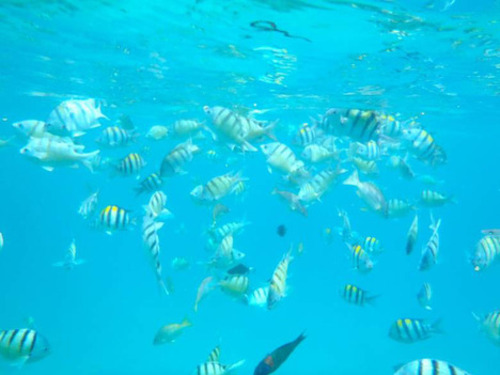Published in the Ocean Watch column, Honolulu Star-Advertiser © Susan Scott
June 6, 2011
Oahu reader Samantha Ryan emailed me that on May 17, while she was snorkeling off the electric plant near Ko Olina, a sea snake swam above her.
I get a lot of emails about sea snake sightings, and that’s fine with me. I share people’s interest in identifying the marine animals swimming in Hawaii’s waters, and also enjoy trying to determine a species from a photo.
 Courtesy Samantha Ryan
Courtesy Samantha Ryan
A possible sea snake was photographed near Ko Olina
My first question to all potential sea snake (and other) sightings is: Did you get a picture? Species can’t be confirmed without a photo or the animal itself.
Samantha did have a photo, but with an unusual story. She did not see the snake while snorkeling. It was only after she got home and downloaded the pictures of some Hawaiian sergeants she took while free-diving that she saw the snakelike thing on the surface above.
“Fortunately, I did not see the snake until I got home and reviewed the pictures,” she wrote, “or it may have scared me into a panic underwater.”
No need to panic, though, for a sea snake encounter. These reptiles eat small fish and aren’t the least bit interested in humans. I can verify this indifference because a dive master once handed me an olive sea snake during a dive in New Caledonia. The snake didn’t even turn its head to see what was holding up its forward progress.
I regret accepting that surprise offering, by the way, and would not do it again. Sea snakes don’t bite humans unprovoked, but holding onto its tail definitely falls in the “provoked” category. These cobra relatives carry a toxin that can be deadly.
Since Samantha’s camera focus was on the fish below, blowing up the image didn’t help me identify the dark squiggly thing at the top of the picture. Expanding it did, however, show some blurred yellow blotches on the body that reminded me of patterns on the snowflake moray.
The surface location of the animal suggests it’s a snake since sea snakes are air-breathing reptiles. Although they can stay underwater for up to two hours, sea snakes, like sea turtles, must come to the surface to breathe.
Each time I look at the picture, I come away with the same conclusion: It looks like a sea snake, but I wouldn’t swear to it. There’s a possibility the creature was an injured eel struggling on the surface.
If it was a snake, it was likely a yellow-bellied sea snake, the only species of sea snake confirmed in Hawaii’s waters, and the most widespread of the world’s 55 species. Yellow-bellied snakes drift in ocean currents on the surface of warm waters in the Pacific Ocean from Central America to Australia, and across the Indian Ocean.
The species is rare in Hawaii, showing up most often during years of unusual ocean currents, such as those caused by El Niño and La Niña events. Hawaii is currently at the end of a La Niña cycle.
It’s hard to know how many yellow-bellied sea snakes make it here because not all sightings are reported. But they are rare. Only three confirmed reports of yellow-bellied sea snakes occurred in Hawaii waters in the past decade, the most recent one in December in Keehi Lagoon.
And then there’s Samantha’s creature, which might be the fourth.
Or not. I leave it to you.